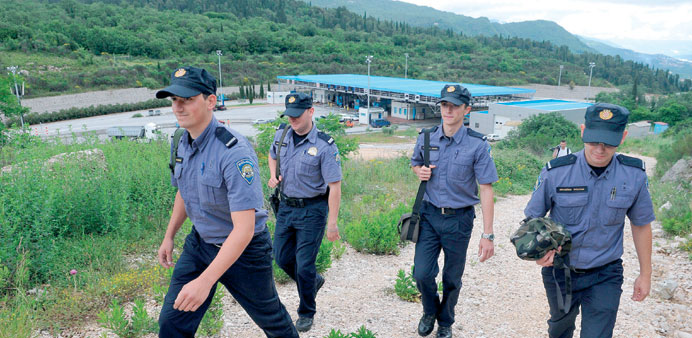Croatian border police officers patrol along the border between Croatia and Montenegro, close to the village of Karasovici.
By Lajla Veselica, AFP/Karasovici, Croatia
When Croatia becomes the 28th member of the European Union, it will shoulder a major task – guarding the bloc’s longest external land border in a region notorious for trafficking.
Croatia lies on the so-called Balkans route which stretches from Turkey across Greece, Macedonia and Serbia, and is used by criminal gangs to smuggle people, drugs or weapons.
Croatian authorities must monitor a border more than 1,300km long – surpassing Finland’s frontier with Russia – which besides Serbia touches the non-EU states of Bosnia and Montenegro.
At the Karasovici crossing, nestled among pine-covered hills at Croatia’s far south border with Montenegro, police official Stane Urlovic said: “Drugs and illegal immigrants are our main concern.”
Only last year, some 6,500 would-be migrants were caught in Croatia on their way to Western Europe. They came mainly from Afghanistan, Syria, Turkey and Albania.
Urlovic said that illegal immigrants – mostly men in their late 20s, but also couples with babies – often try to sneak in only a few hundred metres away from the Karasovici crossing.
“Sometimes we catch the same people only a few hours after we have caught them for the first time and sent them back to Montenegro,” she said.
Traffickers charge for a trip from Istanbul to an EU country between 5,000 to 6,000 euros ($6,700 to 8,000), police say.
EU border management agency FRONTEX said the illegal crossings in the region – amounting to about 35,000 people – rose by 33% in 2012 compared with the year before.
Also last year, around 600kg of various drugs were seized at Croatian borders, and the smuggling of stolen vehicles is on the rise, police said.
To meet the challenges, Croatia has spent millions euros of European assistance funds to improve border infrastructure, modernise equipment and train police officers, said interior ministry official Gilio Toic Sintic.
Some 6,000 officers are involved in the monitoring and control of the land borders with Montenegro, Serbia and Bosnia, he said.
The 1,011km-long border with Bosnia is the most challenging not only for its length but also for its difficult terrain dotted with rivers and impassable mountains.
At a police station in Metkovic – a southern Croatian town part of which lies in Bosnia – mostly young officers monitor around the clock six “suspicious points” on big screens.
“This is a suitable terrain for (illegal) migrants, they can hide easily and ‘get lost’ in the town,” said the head of the regional border police Mato Barisic.
He said Croatia’s EU entry would not change much, although the country could now become a destination rather than just a transit point.
“We have been preparing for this for years,” he said pointing to a nearby brand new Klek-Neum crossing on the Adriatic coast with Bosnia, where some 8mn people, mostly tourists, pass every year.

